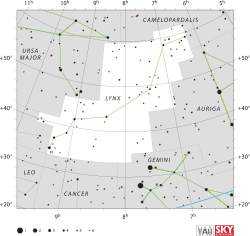Lynx (constellation)
| Constellation | |
|
| |
| Abbreviation | Lyn |
|---|---|
| Genitive | Lyncis |
| Pronunciation |
/ˈlɪŋks/, genitive /ˈlɪnsᵻs/ |
| Symbolism | the Lynx |
| Right ascension | 8 |
| Declination | +45 |
| Family | Ursa Major |
| Quadrant | NQ2 |
| Area | 545 sq. deg. (28th) |
| Main stars | 4 |
| Bayer/Flamsteed stars | 42 |
| Stars with planets | 5 |
| Stars brighter than 3.00m | 0 |
| Stars within 10.00 pc (32.62 ly) | 1 |
| Brightest star | α Lyn (3.14m) |
| Nearest star |
LHS 1963 (26.62 ly, 8.16 pc) |
| Messier objects | 0 |
| Meteor showers |
????? ????? |
| Bordering constellations |
Ursa Major Camelopardalis Auriga Gemini Cancer Leo (corner) Leo Minor |
|
Visible at latitudes between +90° and −55°. Best visible at 21:00 (9 p.m.) during the month of March. | |
Lynx is a constellation in the northern sky, introduced in the 17th century by Johannes Hevelius. It is named after the lynx, a genus of cats. It is mostly a very faint constellation; its brightest stars form a zigzag line.
History

Johannes Hevelius defined the constellation in the 17th century as he wanted to fill the open gap between the constellations Ursa Major and Auriga. He supposedly named it Lynx because of its faintness: only the lynx-eyed (or those of good sight) would have been able to recognize it. Hevelius gave it the alternate name of Tiger in his catalogue as well as Lynx, but kept the latter name only in his atlas. Flamsteed adopted the constellation in his catalogue and atlas.[1]
According to Richard H. Allen, the chief stars in Lynx "might well have been utilized by the modern constructor, whoever he was, of our Ursa Major to complete the quartette of feet."[2]
Notable features
Francis Baily gave a single star a Bayer designation—Alpha Lyncis—the only star above magnitude 4.5. Flamsteed numbered 44 stars, though several lie across the boundary in Ursa Major.[1] The brightest star in this constellation is Alpha Lyncis, an orange giant of spectral type K7III located 203 ± 2 light-years distant from Earth.[3] The only named star is Alsciaukat (from the Arabic for thorn), also known as 31 Lyncis, or κ Lyncis.
Five star systems have been found to contain exoplanets.
Lynx's most notable deep sky object is the Intergalactic Tramp NGC 2419, also called the "Intergalactic Wanderer", a globular cluster that is one of the most distant known of its kind at a distance of 300,000 light-years from Earth. It is likely that NGC 2419 is in a highly elliptical orbit around the Milky Way. It has a magnitude of 10.3 and is a Shapley class II cluster; the classification indicates that it is extremely concentrated at its center. Originally thought to be a star, NGC 2419 was discovered to be a globular cluster by Carl Lampland.[4]
Namesakes
Lynx has been used for the name of four United States Navy ships: USS Lynx (1814), USS Lynx (SP-2), USS Lynx (AK-100) and USS Lynx II (SP-730), of which only USS Lynx (AK-100) was named for the constellation.
See also
References
- 1 2 Wagman, Morton (2003). Lost Stars: Lost, Missing and Troublesome Stars from the Catalogues of Johannes Bayer, Nicholas Louis de Lacaille, John Flamsteed, and Sundry Others. Blacksburg, VA: The McDonald & Woodward Publishing Company. pp. 202–03. ISBN 978-0-939923-78-6.
- ↑ Richard H. Allen (1899) Star Names: Their Lore and Meaning , p. 280 (http://penelope.uchicago.edu/Thayer/E/Gazetteer/Topics/astronomy/_Texts/secondary/ALLSTA/Lynx*.html).
- ↑ van Leeuwen, F. (2007). "Validation of the New Hipparcos Reduction". Astronomy and Astrophysics 474 (2): 653–64. arXiv:0708.1752. Bibcode:2007A&A...474..653V. doi:10.1051/0004-6361:20078357.
- ↑ Levy 2005, pp. 168-169.
- Universe: The Definitive Visual Dictionary, Robert Dinwiddie et al., DK Adult Publishing, (2005), pg. 346.
- Levy, David H. (2005). Deep Sky Objects. Prometheus Books. ISBN 1-59102-361-0.
- Ian Ridpath and Wil Tirion (2007). Stars and Planets Guide, Collins, London. ISBN 978-0-00-725120-9. Princeton University Press, Princeton. ISBN 978-0-691-13556-4.
- Ferris, Timothy. Seeing in the Dark. 2002. p. 244
External links
| Wikimedia Commons has media related to: |
- The Deep Photographic Guide to the Constellations: Lynx
- Star Tales – Lynx
- Lynx Constellation at Constellation Guide
| ||||||||||||||||||||||||||||||||||||||||
| ||||||||||||||||||||||||||||||||||||||||
Coordinates: ![]() 08h 00m 00s, +45° 00′ 00″
08h 00m 00s, +45° 00′ 00″
|
